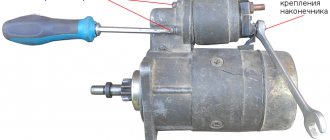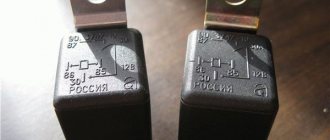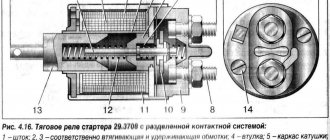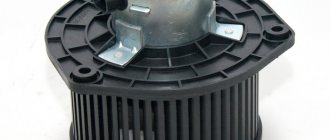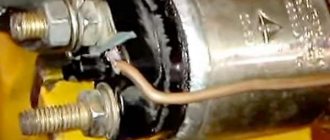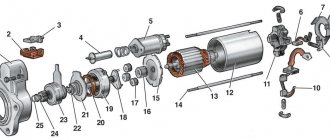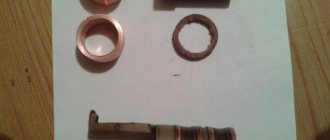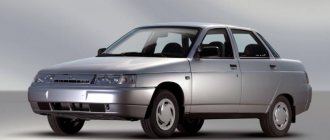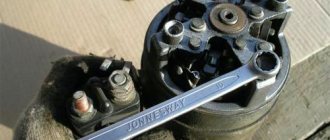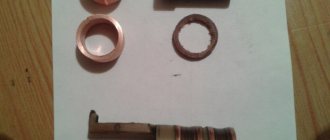Probably all car owners have found themselves in a situation in which the engine does not want to start. Basically, this problem can be solved by charging the battery or cleaning the contact elements. At the same time, sometimes it happens that the problem cannot be solved without repairing the starter solenoid relay. We’ll talk now about how to carry out such a procedure. For those who do not want to figure it out on their own, you can immediately contact a service center where the starter will be repaired efficiently.
Device Features
Before you think about how to disassemble the starter solenoid relay, you need to become familiar with the operating principle of this system. To begin with, it is worth understanding that the device runs on battery power. On the other hand, the device is capable of creating a parallel magnetic field, which affects the armature. The return spring is then compressed, which drives the bendix. At the end it connects to the splines that are on the flywheel.
The principle of operation of the element is based on the subsequent closure of the corresponding contacts. At the same time, due to the action of the magnetic field, the armature of the coil is constantly located inside.
When the engine is started, access to power is limited. At the same time, the spring begins to return to its original position, and the bendix disengages. If you are interested in more detail about the operation of the starter solenoid relay, the video on our page will help you figure it all out.
Video on how to repair the starter retractor relay with your own hands:
How to check the starter retractor relay: video and description
First of all, diagnostic work should begin with checking the starter. To carry out the check, one turn of the key in the ignition is enough. If the device does not work, you will hear characteristic clicks, which confirms that the element is faulty.
Next, you should bridge the contacts, which are represented by two copper bolts located on the relay cover. If the device starts to spin, then most likely the solenoid relay needs to be repaired.
At the same time, another option is also possible. In this case, disconnect the starter. It is important to do everything extremely carefully, because the rotational force of the mechanism is relatively high, so the likelihood of injury is quite high.
After completing the dismantling procedure, we place the part on the ground. Using a wire, we connect the contact terminal with the positive one, as well as the ground of the starter with the ground of the battery. After such operations are completed, you should see the relay start up, which is accompanied by a characteristic clicking sound. If the relay activation is not detected, we begin to inspect the contacts - most likely, they are slightly burnt.
In addition, a breakdown of the system is also indicated by the situation when the relay does not turn off, even if the power unit has already started. You can tell by the buzzing sound coming from the system.
Another symptom is a characteristic click from the ignition system, but the starter never starts working. Finally, a sign will also be the mechanism running idle after the key is turned. At the same time, we see that the engine has not started.
If you don't know how to check the operation of the starter relay, the video on our website will help you figure it out. In it you will find a detailed description of how exactly to carry out a comprehensive diagnosis of this unit.
Video recommendation on how to disassemble the starter solenoid relay:
How it works
The design of the “ten” starter is such that inside it there is a retractor relay, which is responsible for the rotation of the drive gears. When the gears engage the teeth of the crankshaft flywheel, starting occurs. Therefore, if the retractor does not work, then you will not be able to start the engine.
Plus, when the contacts on the traction winding are closed, the starter motor is supplied with power from the battery. The contacts are washed out, the blocking is activated, due to which the retractor winding is “cut out”.
The retractor is controlled directly from the ignition switch. Plus it plays the role of starter protection. The fact that the relay will require an impressive amount of current leads to gradual wear of the contacts in the contact group.
This can be noticed by the unclear start of the power unit; periodically the starter may not operate or may rotate the engine slowly. You can solve this problem on your own.
How to repair a relay with your own hands
Basically, repair work involves dismantling a number of mechanisms. Here it is important to remember to take precautions - do not rush, do everything very carefully, turn off the power to the machine. It is also worth considering carefully whether there is a need to repair the starter retractor relay yourself. In the absence of the necessary skills, abilities and tools, you should entrust everything to the hands of professionals - otherwise you can not only aggravate the breakdown, but also get injured.
At the same time, if you decide to carry out repair work yourself, disconnect the power from the battery. This is the initial step to disassemble the starter, otherwise all the car's wiring may burn out.
What's the end result?
So, as you can see, replacing a faulty solenoid relay is not that difficult . On the other hand, everything must be done very carefully and thoroughly, otherwise there is a high probability of damaging the engine starting system, or getting seriously injured.
Thus, if you are worried about whether you can carry out repairs yourself, it is better to seek help from professionals - they will help you quickly restore the functionality of this unit.
Video review of repairing the starter solenoid relay yourself:
A faulty starter relay is often the reason why the car refuses to start when the key is turned in the ignition. Perhaps these are not the most pleasant moments in the life of any driver. Therefore, in such cases, it is important to know how to check the starter solenoid relay, and how to start the car if it does not work.
We will tell you about the purpose of the starter solenoid relay and its structure, how you can check it and perform simple repairs yourself.
At the end of this article, watch the video that shows how to start your car if the starter solenoid relay is not working.
Also on our website you can find information about other common causes of starter malfunction with step-by-step instructions on what to do if the starter does not work.
When, when you turn the key in the ignition switch, you can clearly hear that the starter is idling, then the cause of this malfunction may be the solenoid relay. But before you start diagnosing it, you should know the purpose of this electrical unit.
What is better – repairing or replacing the “twelve” starter?
Replacing the model 57.3708 mechanism we are describing is usually required after just a few years of its operation. In most cases, car enthusiasts prefer not to repair the device when it stops working (does not turn) or functions abnormally (problems with starting), but to install a new mechanism.
However, sometimes replacing the starter is not necessary. Often it does not turn for a trivial reason - due to the fact that the relay fixing bolts are oxidized or weakened. Such phenomena are caused by the ingress of road dirt and droplets of moisture into the installation area of the “starting” mechanism. This problem, as you understand, can be solved very easily - by cleaning the contacts (less often, their complete replacement is required).
If the brushes are worn out and the bendex is cracked, it is cheaper and more reasonable to replace these elements. But if the starter does not turn due to a broken relay or breakdown of the windings, replacing the entire assembly seems to be a more competent step. If a decision is made to replace any of its parts, the mechanism should be disassembled; this is not difficult.
Purpose of the starter retractor relay
As you know, a starter is an electric motor that is powered by a battery. When starting the engine, the starter gear must quickly engage with the flywheel ring of the engine crankshaft. At the same time, the starter electric motor is turned on, which rotates the crankshaft - this process in action is clearly visible in the animation below.
The starter solenoid relay is responsible for quickly connecting two toothed parts: the flywheel and the overrunning clutch gear (Bendix). The retractor relay is installed on the starter housing, connecting to the clutch in the front using a lever. If the relay does not push the gear forward, then the starter rotates on its own.
However, the culprit of such a malfunction may be not only the retractor relay, but also the overrunning clutch (read more about Bendix repair). If the clutch is jammed, then the force of the retractor relay is not enough to extend it.
Selecting a part for a VAZ-2110
Often the entire starter assembly is replaced, but we recommend not doing this. The pull-out relay is much cheaper than the entire kit.
The choice of a new relay should be approached with the utmost seriousness, since the quality of the part will determine how long it will serve the owner.
Most VAZ-2110 are equipped with a solenoid relay manufactured by Bosch, with catalog number 2339303293 . The cost of the part is about 2000 rubles.
Analogs
In addition to the proposed version of the original part, there are quite a lot of analogues that can be installed on a car. So, many car enthusiasts do just that. Let's look at what the automotive spare parts market offers the owner of a 2110:
- Cargo 131143 – the cost is 1200 rubles. High quality for little money.
Checking the starter retractor relay
To determine the reason for the lack of connection between the gear elements of the starter and the engine, you should check the functionality of the solenoid relay. For ease of diagnosis, most often it is necessary to dismantle the entire starter.
However, before you begin dismantling the starter, it is advisable to carry out several simple operations that will help identify the problem:
- Check the condition of the battery, the reliability of the terminals, remove oxides from the battery terminals;
- Make sure that the electrical wiring is securely attached to the starter with nuts. If there is corrosion, clean the contacts with fine-grained sandpaper;
- Find the starter switch relay in the car and check its condition.
Starter removal procedure
To remove the starter, you need to disconnect the wires that go to it, and then unscrew the mounting bolts (usually two or three).
Replacement
In fact, it is theoretically possible to repair the relay. But in reality this is rarely justified in terms of financial and time costs.
A much simpler and more rational solution is replacement. The procedure will not take much time, but the unit will definitely work properly and reliably. It is unknown what the result of the repair will be.
If the relay is incorrectly repaired, this can lead to blocking the start of the power unit. The cost of repairing such a problem is much higher than buying a new high-quality relay.
Replacing and installing a new solenoid relay will not be a problem, since the procedure is performed in the reverse order of disassembly.
Proceed with caution, keeping an eye on each item you take apart and put back together. Clean some contacts, if necessary, tighten loose fasteners. Whatever one may say, as the car is used, it shakes violently and vibrates, which leads to the banal loosening of nuts and bolts. What's most interesting is that this often leads to a whole range of problems. Therefore, make sure that each individual fastener is securely fastened.
Repair of starter retractor relay
First, we suggest watching a video instruction on how to replace the solenoid relay yourself, and then we will tell you how to repair it.
Depending on the manufacturer, starters are equipped with a collapsible or non-demountable solenoid relay. To fix a problem with a non-separable element, you just need to buy a new part. All that remains is to unscrew the two mounting bolts, remove the faulty relay and install a new one in its place (see the video above).
In the case of a detachable solenoid relay, you can try to repair it. The repair is as follows:
- Unscrew the screws securing the housing cover.
- Sometimes it is necessary to additionally solder the ends of the winding.
- Removing the cover opens up access to find a possible problem - these are power contacts that may be worn out or burnt:
- in the first case, replacing contacts will help,
- in the second case, the problem can be solved with the help of sanding paper.
- Now all that remains is to assemble the solenoid relay and check its functionality.
- The repaired starter is installed in place, after which its operation can be tested.
And lastly, we recommend watching a video that shows how you can start a motor with a non-working starter solenoid relay.
Removing the starter
In the VAZ 2112, the starter relay is located on the starter itself, so it is better to remove it as an assembly, in this case it will be much easier to remove the relay and at the same time you will perform preventative maintenance on the starter itself. So:
- To easily remove the starter, you need to drive onto a viewing hole, overpass or lift and turn off the power to the car by disconnecting the battery
- If protection or a mudguard was installed, then they will have to be removed
- There is a nut at the bottom of the starter (starter), which is convenient to get to from under the bottom of the car; this nut must be unscrewed
- Then, from the top side of the motor, you need to disconnect (remove) the terminals located on the solenoid relay, then the upper nut that secures the starter
- After that it comes out easily
- Now you can disconnect the solenoid relay from the starter.
Let's move on to removing the relay
The entire replacement procedure can be easily performed independently, and for this you only need these instructions and a minimum of tools:
- Slotted screwdriver (also flat)
- Ratchet with extension and socket "8"
- Soldering iron needed for repairs
Of course, you can unscrew and replace it without removing the starter from the machine; it is still recommended to do this with the device removed:
- After removal (described above), unscrew the nut that secures the terminal to the stud, this is clearly shown in the photo:
Unscrew the nut using an “8” socket with a ratchet and remove the starter terminal from the stud
- Carefully remove the terminal, then move it a little to the side so that it does not interfere
- Now we unfold the starter, and from this side we unscrew the two screws using the prepared flat screwdriver
- All this can be seen in the next picture
We unscrew the screws that secure the relay, turning the starter to the other side
- Now remove it without experiencing any difficulties; to do this, gently pull its body back
- If it suddenly doesn’t come off, it means you need to lift it slightly in order to disengage it.
- It is important not to lose the spring, which can easily jump out if disconnected carelessly
- In addition, you should make sure that the core remains in place after this - inside the starter housing
- Proceed to check the relay by disconnecting it
How to start a car if the starter solenoid relay does not work
Starter and retractor relay VAZ 2110
If the car suddenly stops starting, there are no characteristic sounds before starting the engine, or a strange “humming” noise appears, then the starter solenoid relay may be damaged. Naturally, the device can sometimes work normally without showing signs of breakdown, but at the most inopportune moments the car has to be started from the pusher. In this situation, only replacing the retractor on the VAZ 2110 starter will change everything for the better. Symptoms of the malfunction are different, for example, the appearance of clicks at the relay, lack of cranking of the starter, lack of signs of life when turning the ignition key, etc. It is worth noting that replacing the VAZ 2110 retractor starter can be done with your own hands.
Monitoring the technical condition of the mechanism
The driver must know how to check the starter solenoid relay himself. Attention should be paid to the appearance of a characteristic sound: when the key is turned, a click appears in the ignition switch. Further attempts to start the car end in a series of clicks and jerks. Signs such as these indicate the need for the following check:
Further actions of the car owner depend on the nature of the detected malfunction. If the device runs too fast or slow, we are talking about mechanical wear of its individual elements. Retractor mechanisms often fail due to a short circuit. Charred contacts are expressed in a series of clicks, complemented by slow operation of the mechanism.
Planned or emergency replacement of the starter relay is associated with monitoring the technical condition of the starter itself. For preventive purposes, the bolts securing its rear wall are removed. If necessary, the device is freed from accumulated traces of contamination. At the next stage, the Bendix fork and brushes 2112 are checked for physical wear. If any are found, replacement is made.
There is no point in postponing this procedure until later. With further operation there is a high risk of damaging the traction relay. After this, all elements are returned to their place. The rear cover of the starter is closed, and the immediate repair of the starter solenoid relay begins.
Solenoid relay
The VAZ 2110 starter solenoid relay is designed to remotely turn on the electric starter motor. They ensure the clutch of the bendix (see Replacing the bendix on the VAZ 2110 starter on your own) with the flywheel crown. This element structurally consists of: a returning, contact and magnetic system, including two coils - a holding coil, connected to the control terminal and going to the housing, and a retracting coil, connected by the control element.
VAZ 2110 starter solenoid relay
The pipe where the armature is located is a core, inside of which there is a copper winding (the end and beginning of the winding are attached with terminals, one side is connected to the electric motor and the control contact, the other is connected to the control terminal and goes to the housing).
VAZ 2110 retractor clicks and the starter does not turn
The movement of the armature in the core is carried out due to the electromagnetic field, and when the voltage disappears, the armature in the core goes to its initial state. When powered, a magnetic field appears, causing the armature to retract the return springs. When the car engine starts, the voltage begins to disappear, the spring presses on the armature and it returns to its initial position, the contacts open, the Bendix disengages. If the solenoid relay breaks down and before replacing it, you should first make sure that the problem lies in the starter.
Note. It is necessary to exclude the following malfunctions in the car: the presence of scale, battery discharge, traces of oxidation on the terminals, damage to the wiring, loose contacts. The car may not start for these reasons.
Starter mounting diagram and its key features
On the Samara, the starter was fixed with three nuts, but on the VAZ 2112 only two are used to secure it. The mechanism body is made of steel, its back and front covers are attached to each other using pins. The Bendix starter gear is covered with a half-cap of the front cover. There is another half cap on the gearbox.
The mechanism is geared, so it has two shafts. On one, the bendix working gear moves; it is called the drive shaft. The second is the armature shaft. Two shafts require four bushings in the design. Naturally, this reduces (and quite significantly) the system’s time between failures.
But on the other hand, a large number of bushings removes the load from the motor of the DC mechanism.
The starter for the “twelve” has rather “modest” geometric dimensions and at the same time produces high speeds very effectively. Its motor is brushed, four-pole, powered by powerful permanent magnets that are attached directly to the body of the device. The starter weighs about four kilograms, at idle it receives about 80 amperes of current, in operating mode - about 375 amperes.
